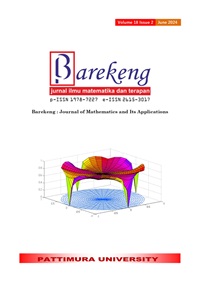THE LEVI DECOMPOSITION OF THE LIE ALGEBRA M_2 (R)⋊gl_2 (R)
Abstract
The idea of the Lie algebra is studied in this research. The decomposition between Levi sub-algebra and the radical can be used to define the finite dimensional Lie algebra. The Levi decomposition is the name for this type of decomposition. The goal of this study is to obtain a Levi decomposition of the Lie algebra of dimension 8. We compute its Levi sub-algebra and the radical of Lie algebra with respect to its basis to achieve this goal. We use literature studies on the Levi decomposition and Lie algebra in Dagli result to produce the radical and Levi sub-algebra. It has been shown that can be decomposed in the terms of the Levi sub-algebra and its radical. In this resulst, it has been given by direct computations and we obtained that the explicit formula of Levi decomposition of the affine Lie algebra whose basis is is written by with is is the Levi sub-algebra of .
Downloads
References
J. E. Humphreys, Introduction to Lie Algebras and Representation Theory, vol. 9. New York, NY: Springer New York, 1972. doi: 10.1007/978-1-4612-6398-2.
Mehmet Dagli, “Levi Decomposition of Lie Algebras; Algorithms for its Computation,”master thesis, Iowa State University , Ames, Iowa, 2004.
J. Hilgert and K.-H. Neeb, Structure and Geometry of Lie Groups. New York, NY: Springer New York, 2012. doi: 10.1007/978-0-387-84794-8.
M. Rais, “La représentation coadjointe du groupe affine,” Annales de l’institut Fourier, vol. 28, no. 1, pp. 207–237, 1978, doi: 10.5802/aif.686.
M. A. Alvarez, M. C. Rodríguez-Vallarte, and G. Salgado, “Contact and Frobenius solvable Lie algebras with abelian nilradical,” Commun Algebra, vol. 46, no. 10, pp. 4344–4354, Oct. 2018, doi: 10.1080/00927872.2018.1439048.
M. A. Alvarez, M. Rodríguez-Vallarte, and G. Salgado, “Contact nilpotent Lie algebras,” Proceedings of the American Mathematical Society, vol. 145, no. 4, pp. 1467–1474, Oct. 2016, doi: 10.1090/proc/13341.
J. R. Gómez, A. Jimenéz-Merchán, and Y. Khakimdjanov, “Low-dimensional filiform Lie algebras,” J Pure Appl Algebra, vol. 130, no. 2, pp. 133–158, Sep. 1998, doi: 10.1016/S0022-4049(97)00096-0.
I. V Mykytyuk and C. E. by B Vinberg, “Structure of the coadjoint orbits of Lie algebras,” Journal of Lie theory, vol. 22, pp.251-268, 2012.
H. Henti, E. Kurniadi, and E. Carnia, “Quasi-Associative Algebras on the Frobenius Lie Algebra M_3 (R)⊕gl_3 (R),” Al-Jabar : Jurnal Pendidikan Matematika, vol. 12, no. 1, pp. 59–69, Jun. 2021, doi: 10.24042/ajpm.v12i1.8485.
B. Csikós and L. Verhóczki, “Classification of Frobenius Lie algebras of dimension ≤6,” Publicationes Mathematicae Debrecen, vol. 70, no. 3–4, pp. 427–451, Apr. 2007, doi: 10.5486/PMD.2007.3556.
A. Diatta and B. Manga, “On Properties of Principal Elements of Frobenius Lie Algebras ,” Journal of Lie Theory, vol. 24, no. 3, pp. 849–864, 2014.
E. Kurniadi, E. Carnia, and A. K. Supriatna, “The construction of real Frobenius Lie algebras from non-commutative nilpotent Lie algebras of dimension,” J Phys Conf Ser, vol. 1722, no. 1, p. 012025, Jan. 2021, doi: 10.1088/1742-6596/1722/1/012025.
E. Kurniadi and H. Ishi, “Harmonic Analysis for 4-Dimensional Real Frobenius Lie Algebras,” 2019, pp. 95–109. doi: 10.1007/978-3-030-26562-5_4.
E. Kurniadi, “Dekomposisi dan Sifat Matriks Struktur Pada Aljabar Lie Frobenius Berdimensi 4,” Prosiding Seminar Nasional Hasil Riset dan Pengabdian (SNHRP)-5, Universitas PGRI Adi Buana, 2021.
E. Kurniadi, N. Gusriani, and B. Subartini, “A Left-Symmetric Structure on The Semi-Direct Sum Real Frobenius Lie Algebra of Dimension 8,” CAUCHY: Jurnal Matematika Murni dan Aplikasi, vol. 7, no. 2, pp. 267–280, Mar. 2022, doi: 10.18860/ca.v7i2.13462.
Copyright (c) 2024 Edi Kurniadi, Henti Henti, Ema Carnia

This work is licensed under a Creative Commons Attribution-ShareAlike 4.0 International License.
Authors who publish with this Journal agree to the following terms:
- Author retain copyright and grant the journal right of first publication with the work simultaneously licensed under a creative commons attribution license that allow others to share the work within an acknowledgement of the work’s authorship and initial publication of this journal.
- Authors are able to enter into separate, additional contractual arrangement for the non-exclusive distribution of the journal’s published version of the work (e.g. acknowledgement of its initial publication in this journal).
- Authors are permitted and encouraged to post their work online (e.g. in institutional repositories or on their websites) prior to and during the submission process, as it can lead to productive exchanges, as well as earlier and greater citation of published works.






1.gif)



